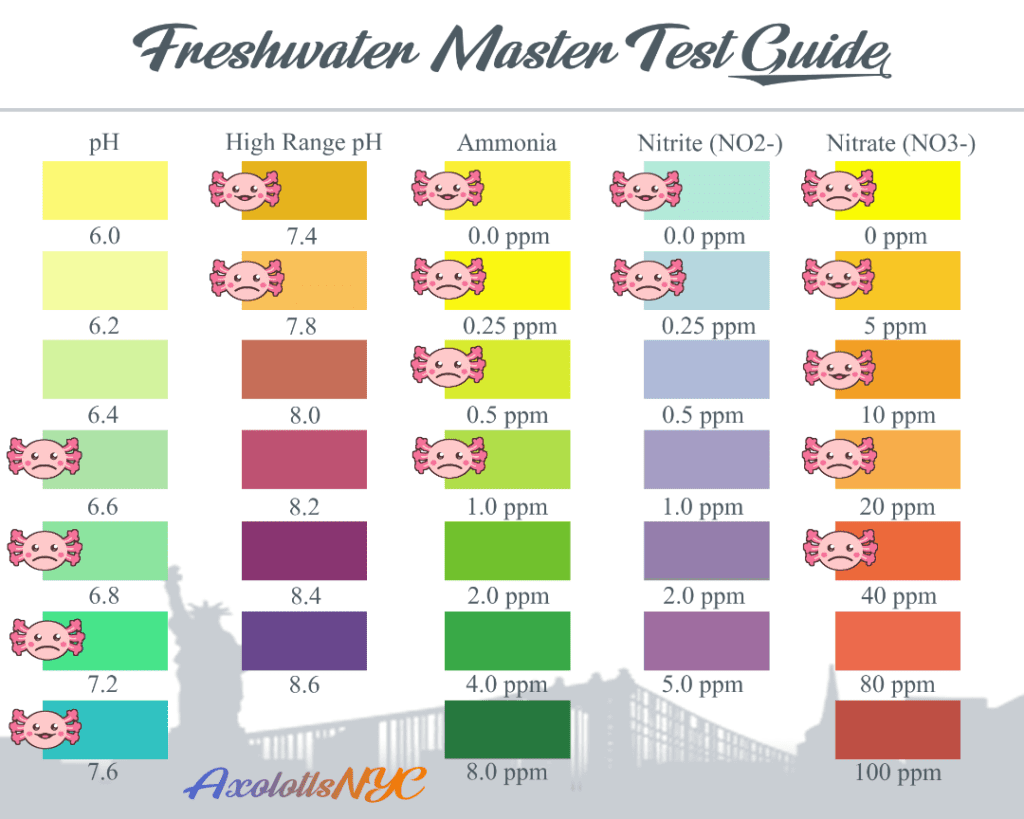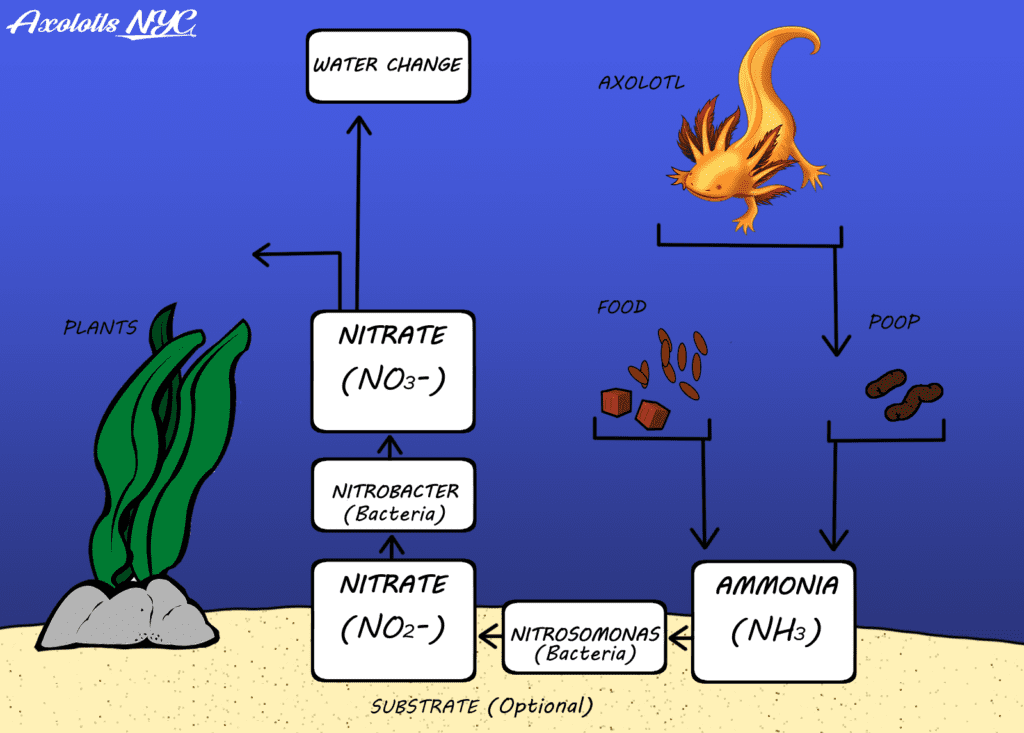What is cycling?
Cycling an aquarium is the process of growing different colonies of beneficial bacteria inside your aquarium to maintain good water quality for your axolotls. These different types of bacteria grow and live in your tank’s filter media and will filter out toxic waste compounds that are constantly generated by your axolotl, excess food, etc.
All aquatic animals constantly release waste ammonia, which is toxic when built up, into their environment, and this ammonia has to be filtered out by beneficial bacteria. The nitrogen cycle is a natural process that enables the ammonia created by your pets to be filtered out into safer compounds. Establishing the nitrogen cycle in your tank is essential before adding any animals to it. When you cycle a tank, you are establishing different types of beneficial bacteria in your aquarium filter media that are able to convert this ammonia into safer compounds. The process that these bacteria carry out is called the nitrogen cycle.
What happens if I do not cycle my aquarium?
Putting an axolotl in an uncycled aquarium would mean the animal living in its own waste, since there are no beneficial bacteria to filter it out. In an uncycled tank, the ammonia and nitrite levels would keep rising to lethal levels, due to the animal constantly producing more waste. Any concentration of ammonia above 0 ppm is toxic to your aquatic pet, and will begin to cause stress & discomfort, sometimes visible or not. Also, high concentrations of nitrite in your tank can result in suffocation, and nitrate levels above 20 ppm will begin to induce stress as well.
Steps to cycling your aquarium
Assuming you already have your API Freshwater Master Test Kit:
- Add ammonia in your aquarium in order to get a reading of 1-2 ppm.
If you are using Dr. Tim’s ammonium chloride, the dosage is 1 drop per gallon = 1 ppm ammonia. You can also add some food that will break down or 2-3 feeder goldfish as they are extremely hardy and can help jumpstart the process. - Check your water parameters every few days until you notice that ammonia has decreased or nitrite has risen.
When ammonia decreases in your tank, nitrite increases. Once you notice the presence of nitrite levels rising in your tank, it means your cycle has started! Beneficial bacteria are consuming the ammonia in your tank and converting it into nitrite. - Test your parameters every day, and dose more ammonia whenever it falls below 1-2 ppm.
Once your cycle has begun, your ammonia will decrease daily. Whenever your ammonia level drops below 1-2 ppm, make sure you add just enough to get it back up to 1-2 ppm. The overall goal for cycling is to get 2 ppm of ammonia to completely decrease to 0 ppm in 24 hours. - Do not let your nitrite level get too high!
If your nitrite has begun to spike, start dosing less ammonia per day. It is okay to only dose up to 0.5-0.75 ppm ammonia until your nitrite level begins to decrease on its own. The beneficial bacteria that consume nitrite sometimes need more time to grow than the ammonia-consuming bacteria, so it may be necessary to let them catch up in this way. Once your nitrite begins to decrease on its own, you may work back up to dosing 2 ppm ammonia per day again. - Keep an eye on your nitrate level.
If at any point during cycling your nitrate level goes off the chart, a water change should be performed. However, it is recommended that you both temperature match and dechlorinate the water before adding it to your tank to avoid shocking your newly established bacteria. Generally try to avoid water changes while cycling, unless you accidentally dose too much ammonia or your nitrite/nitrate level becomes too high.
Your aquarium is fully cycled once it can process 2 ppm of ammonia into 0 ppm ammonia and 0 ppm nitrite in 24 hours.
Once your aquarium is cycled, you must do several water changes to bring your nitrate level down to below 20 ppm. During the days that you perform these water changes, make sure you remember to keep dosing ammonia daily up until the day that your aquatic animal actually goes into the tank. The bacteria will begin to die if they are not fed ammonia every day. Keeping your ammonia level around 1 ppm each day provides just enough food to keep your bacteria alive while you do daily water changes to bring your nitrate down before putting your axolotl into the tank.
Once the nitrate level has been brought down to below 20 ppm with water changes, your axolotl can be added to the aquarium as long as ammonia and nitrite are both 0 ppm.
Problems encountered while cycling
Low pH
Make sure your pH always stays above 6.5 in order to avoid stalling the nitrogen cycle. If the pH in your tank is dropping too low, you may raise it naturally with crushed coral in a media bag in your tank or filter or 1 teaspoon of baking soda diluted in 2 cups of water directly into the tank water. A pH below 6.0 will cause the nitrogen cycle to cease completely.
How to speed up the cycle
Used media filter
The most effective way to quickly cycle an aquarium is to use filter media from an already established tank. You may inquire at local pet shops to see if they sell established filters or filter media, or you could try asking on local online groups. This filter media would need to be carefully acclimated to your tank in order for it to help with your cycle. The bacteria on the filter are sensitive to changes in environment and should be carefully drip acclimated to your tank. Water from an established aquarium will also help establish a healthy bacteria colony in your filter, but you still need to test & dose as needed daily.
Bottled bacteria products
Bottled bacteria such as Seachem Stability can also help jumpstart the cycle. However, pet stores’ claims that bacteria in a bottle can instantly cycle your tank or cycle your tank without ammonia are false. Everything needs time to feed, grow, etc. Always follow the dosage directions on any products you choose to use.
DO NOT wash or replace your filter media while cycling. When you do wash your filter media in the future, make sure it is never with tap water. When filter media gets dirty, you may rinse it in old tank water only, as both the chlorine in tap water and the sudden temperature change will kill your bacteria. Never replace all of your filter media at a given time. If you have a filter that has replaceable cartridges, you will need to buy reusable media, such as coarse sponges, for the filter instead.
What happens if I do not cycle my aquarium?
Placing an animal in an uncycled aquarium would result in the animal living in its own waste, since there are no beneficial bacteria to filter it out. In an uncycled tank, the ammonia and nitrite levels would continue to rise to lethal levels, due to the aquatic animal constantly generating more of it.


